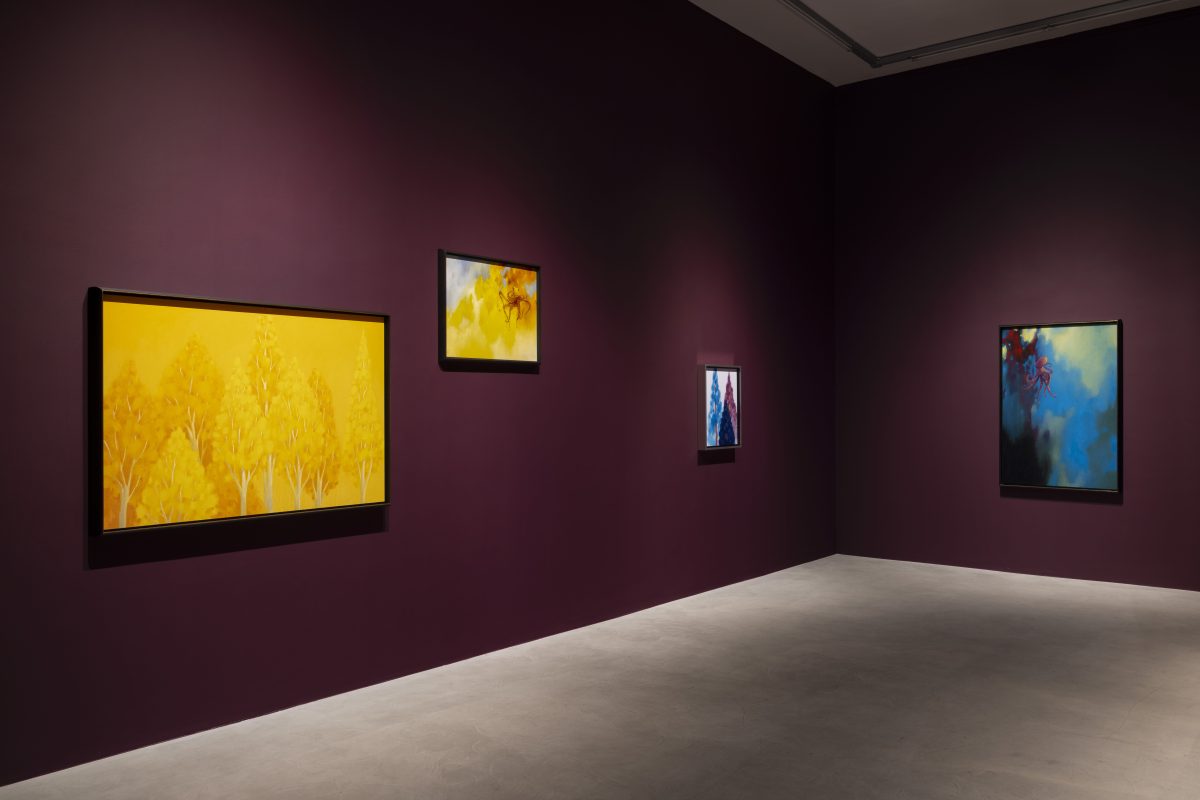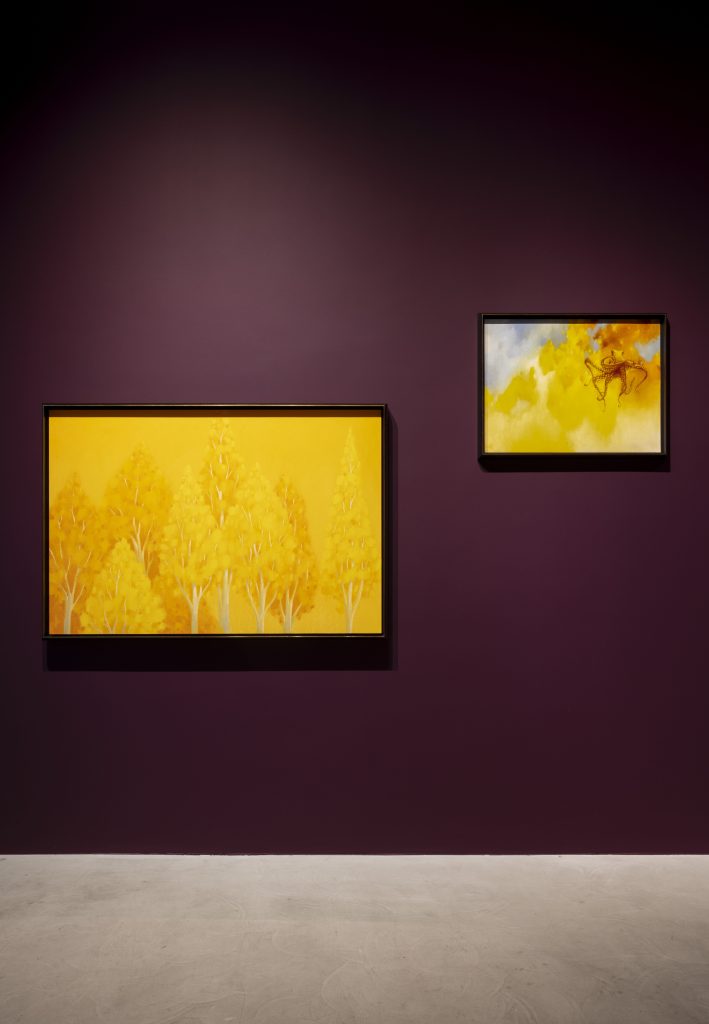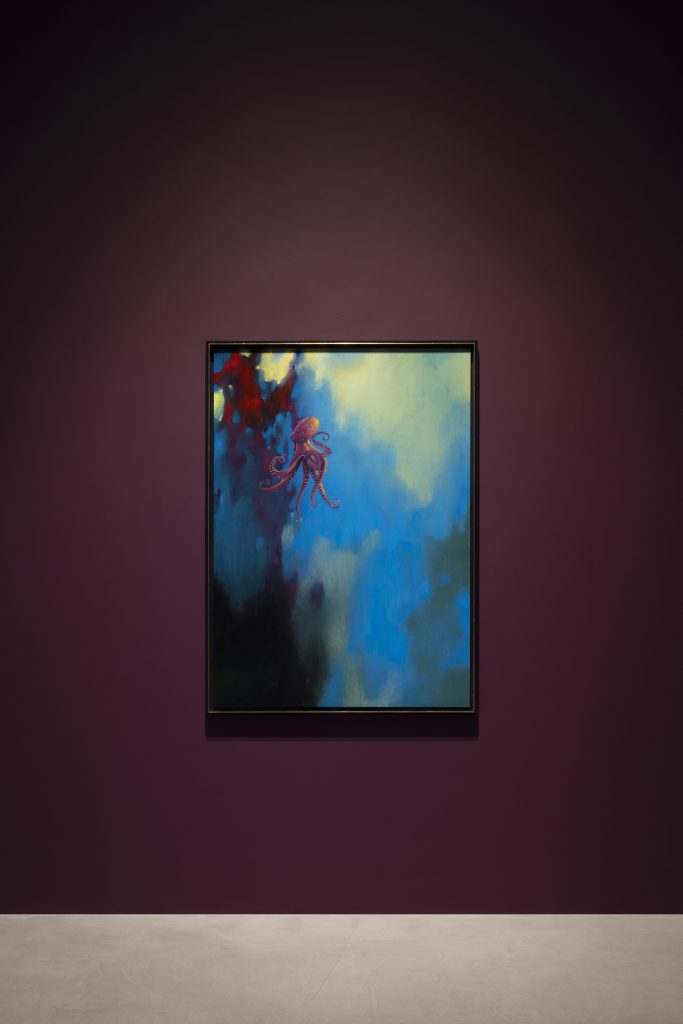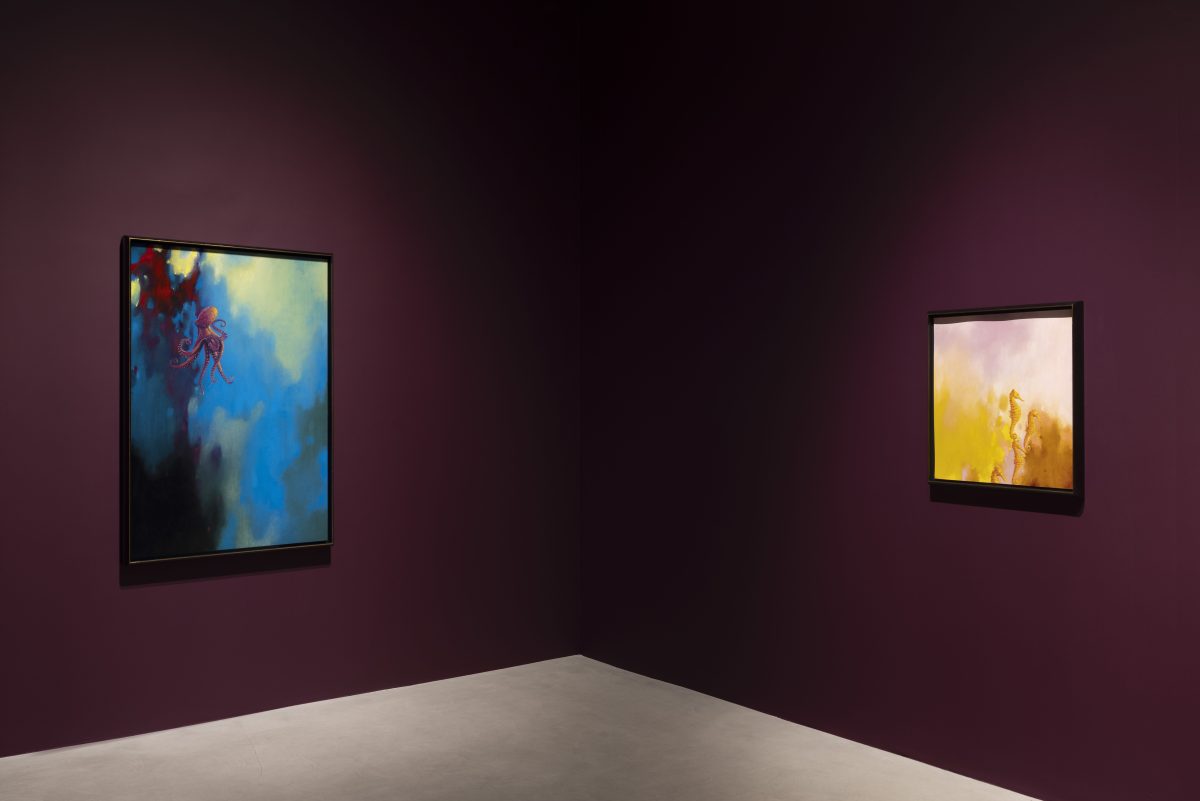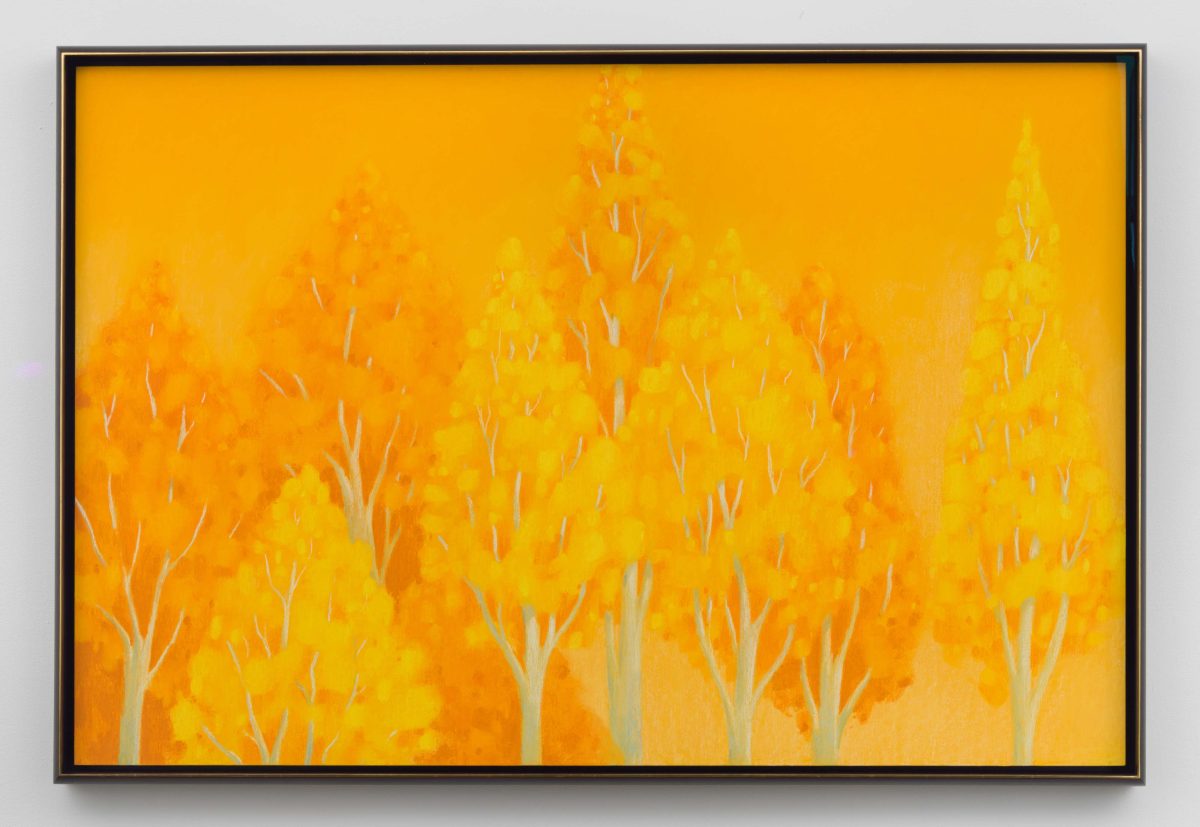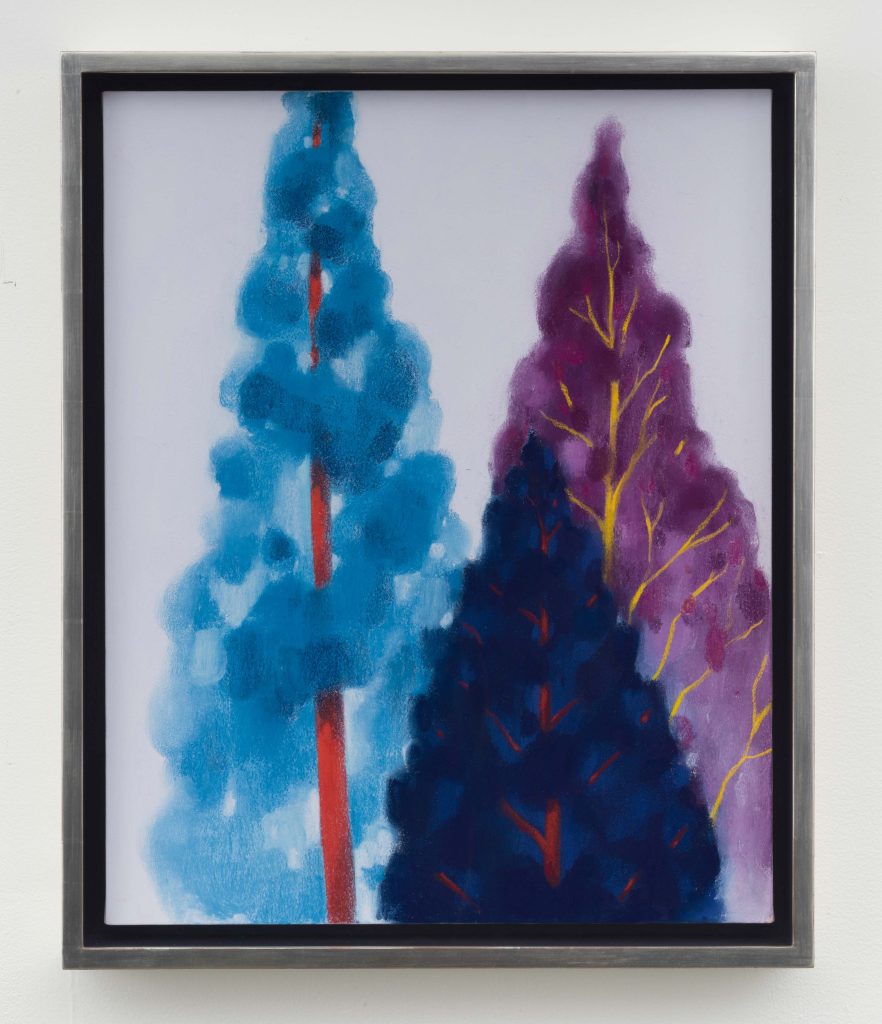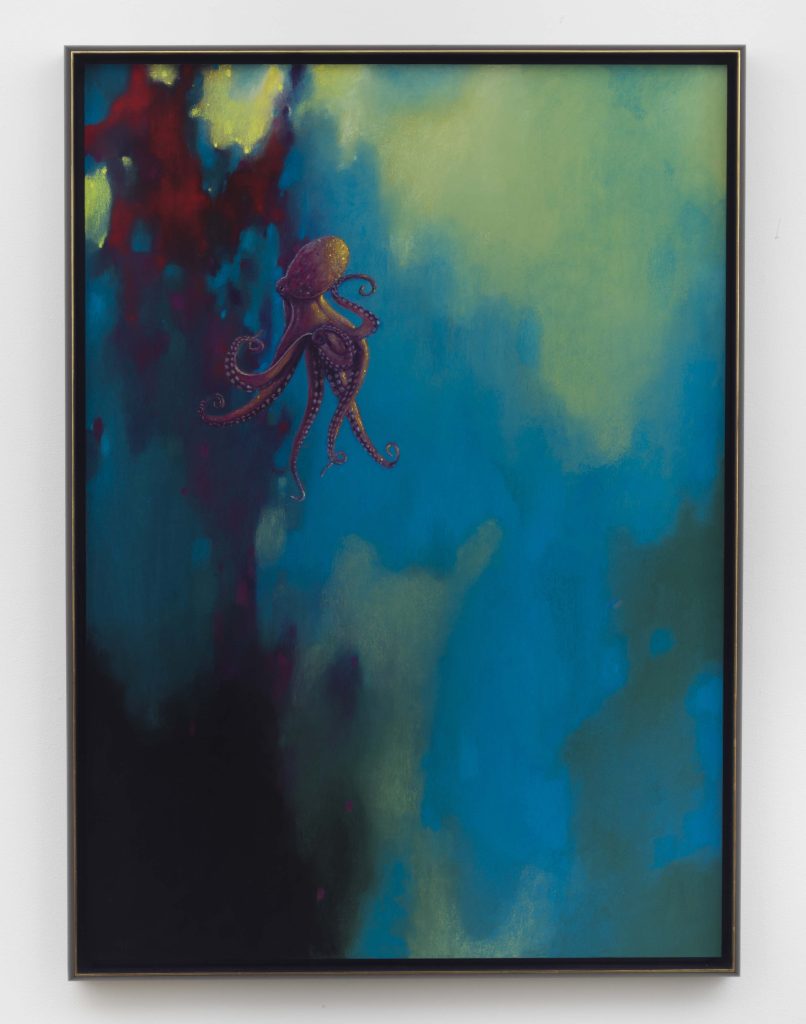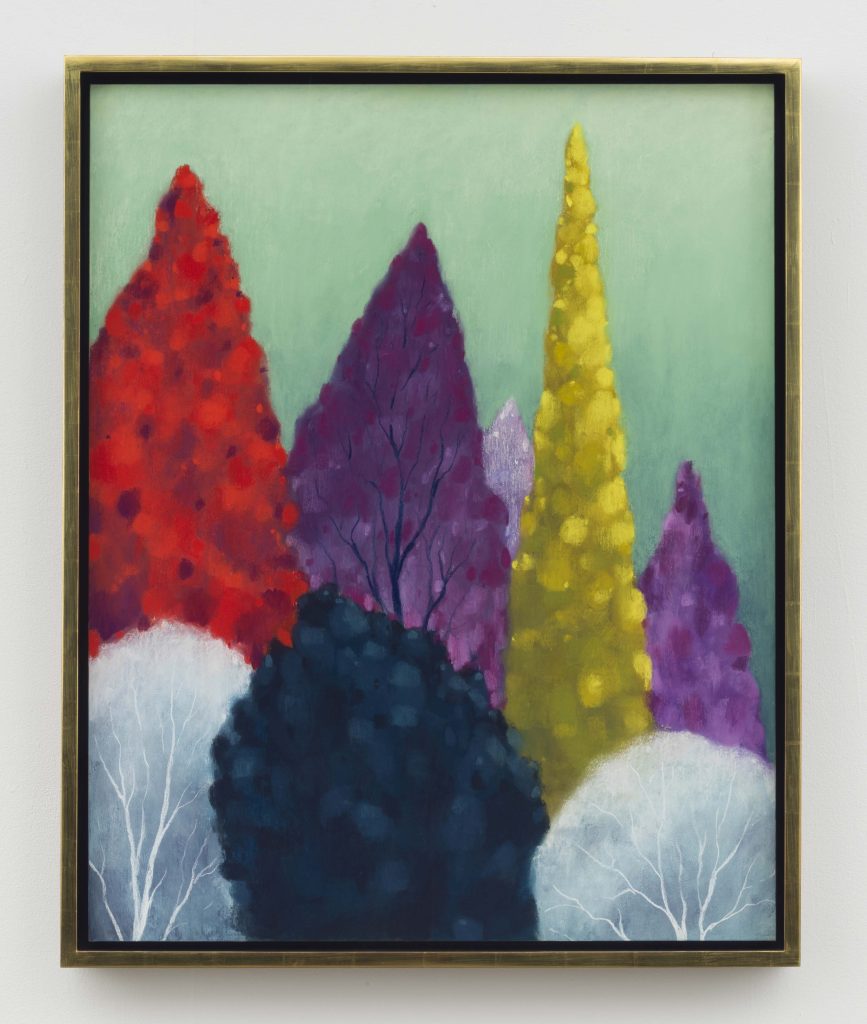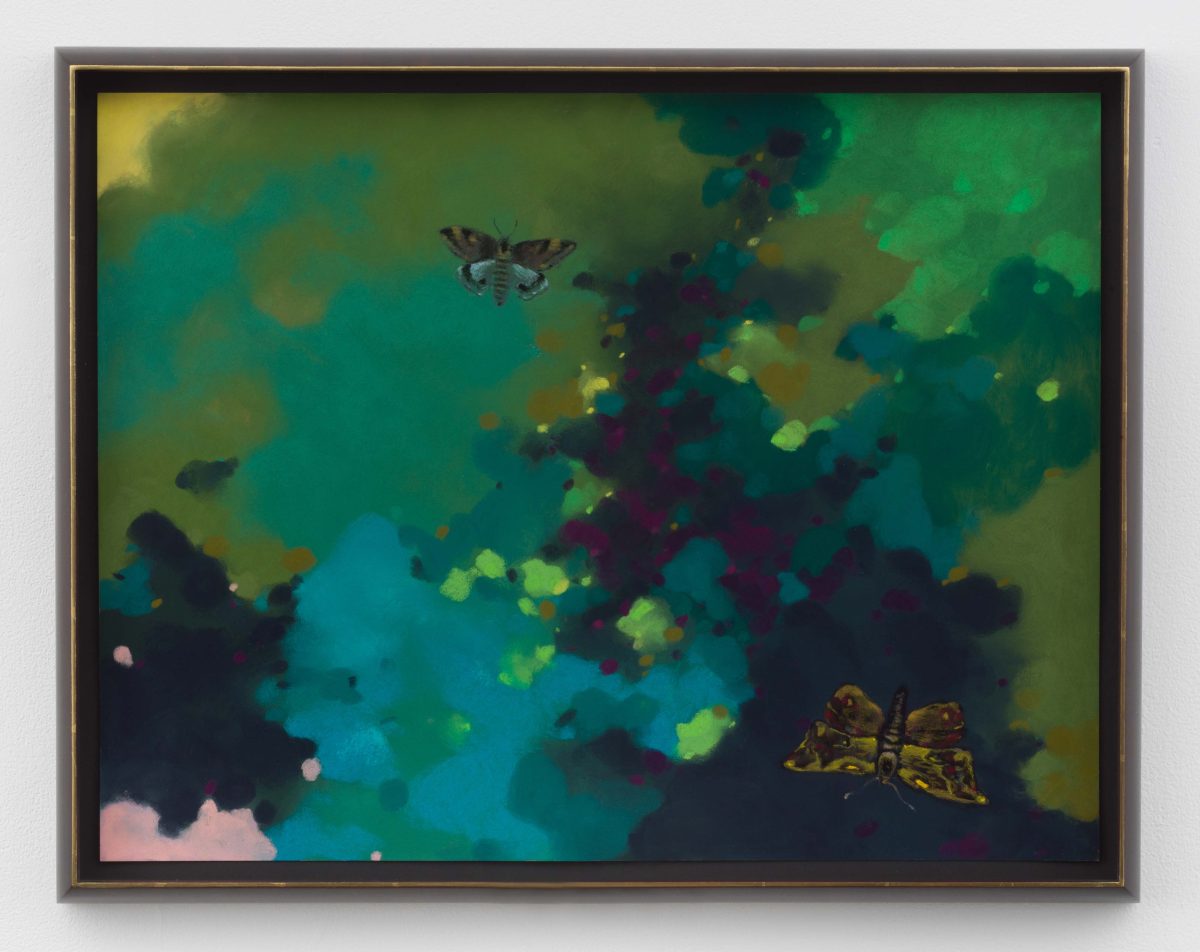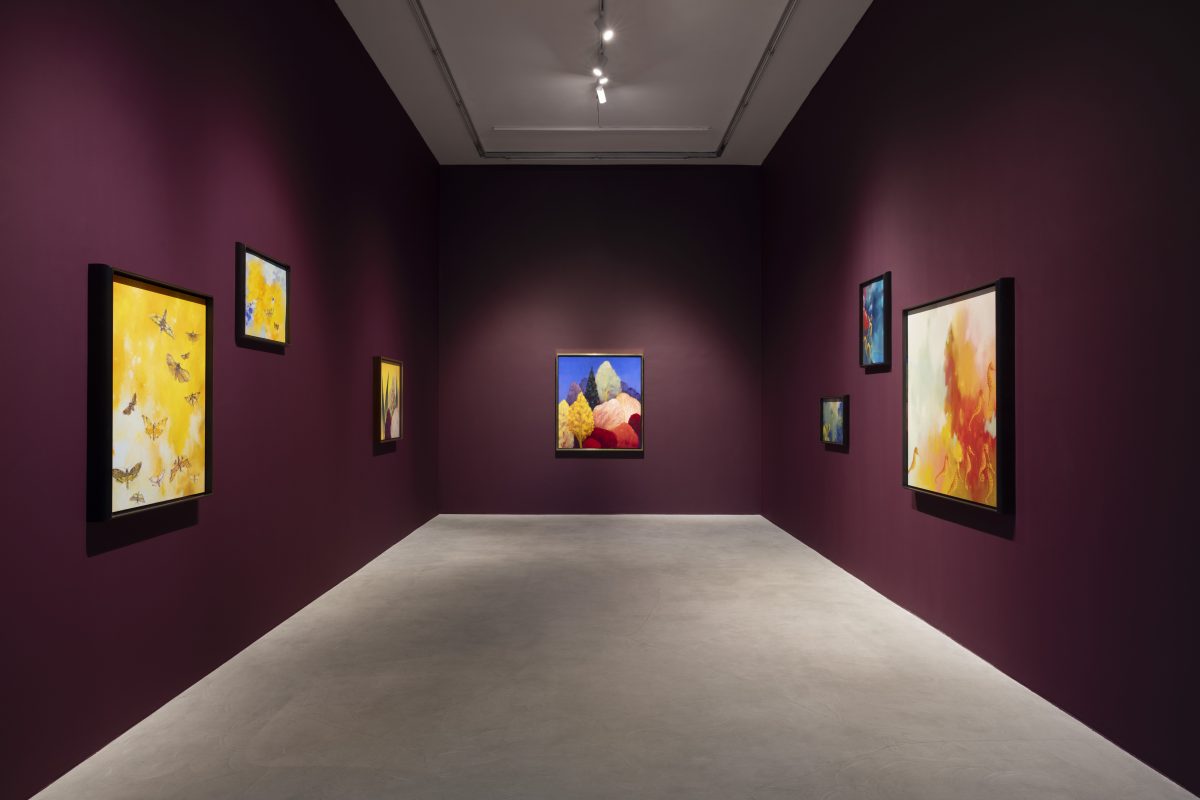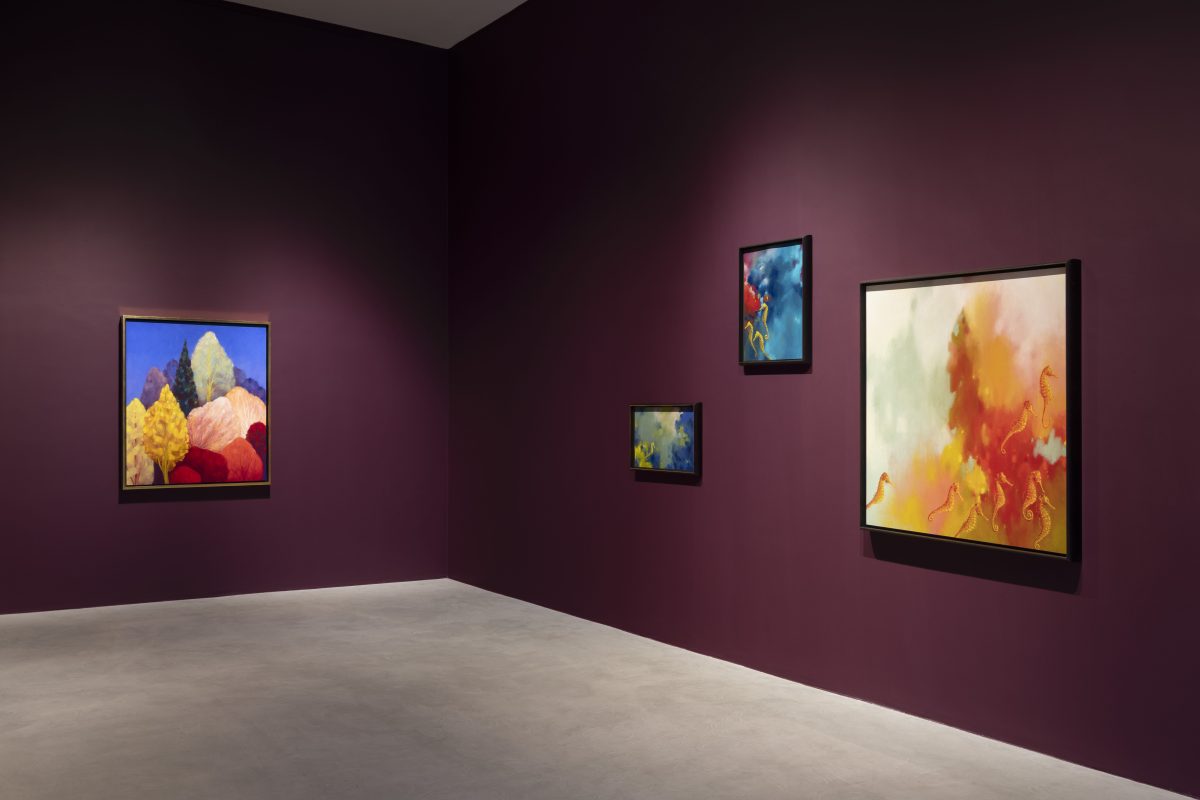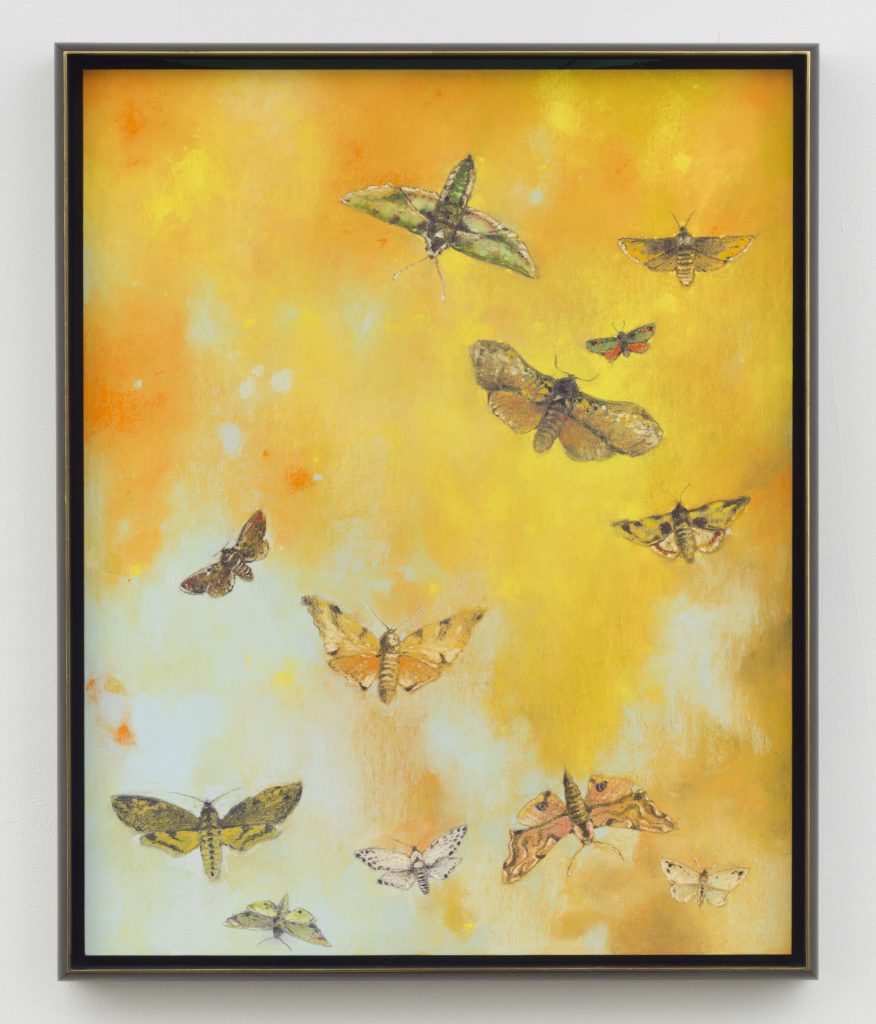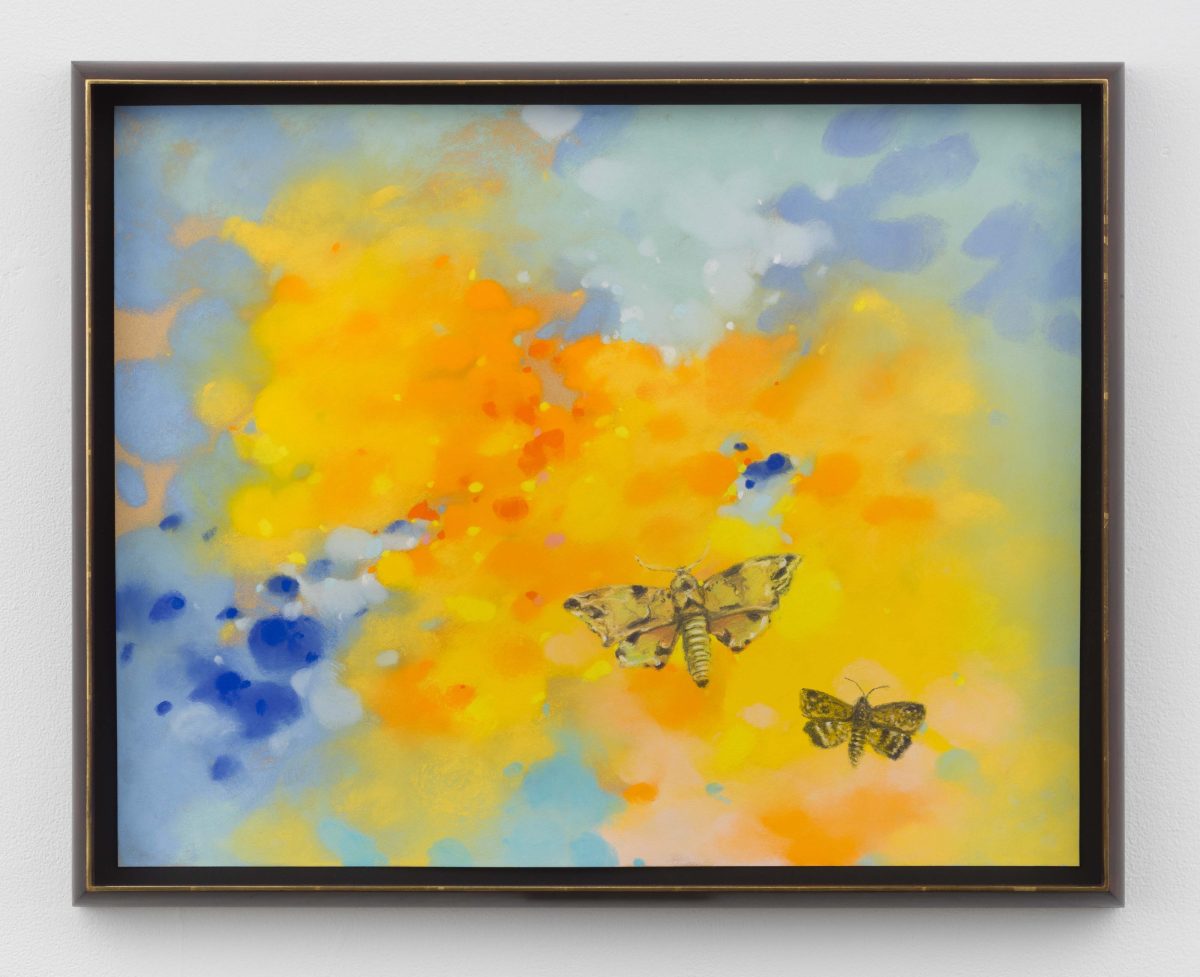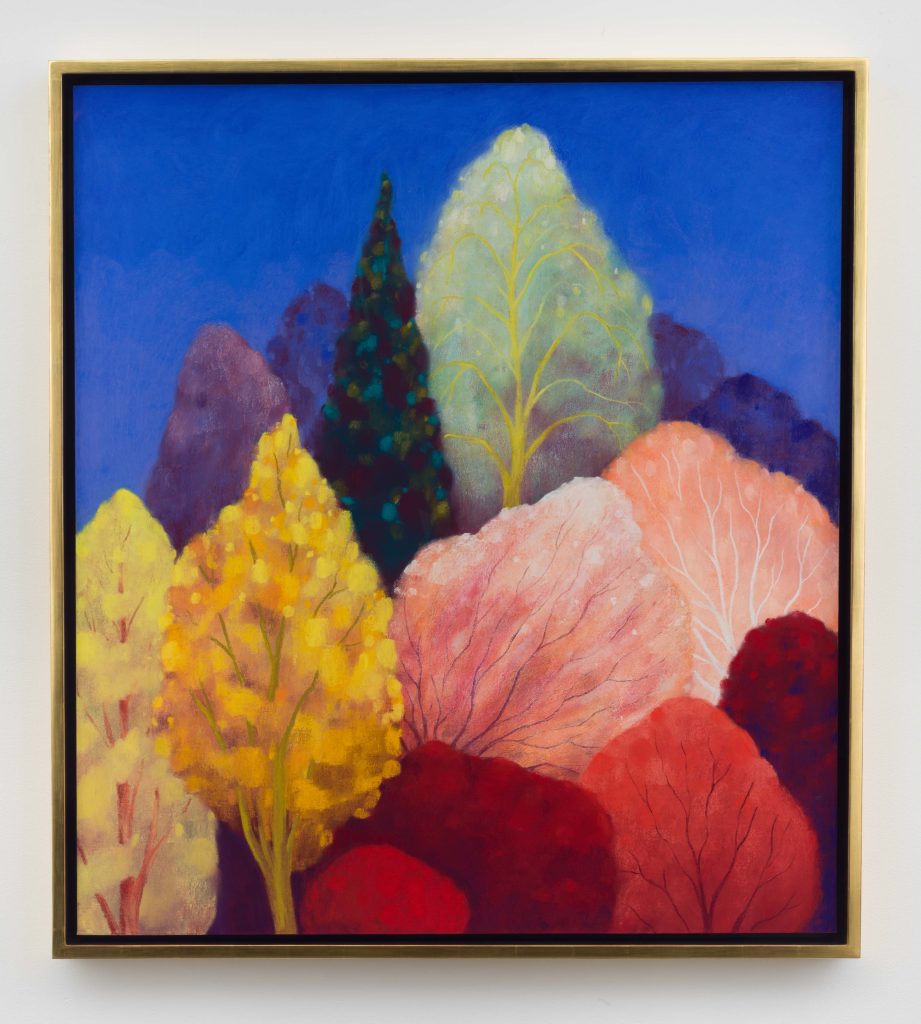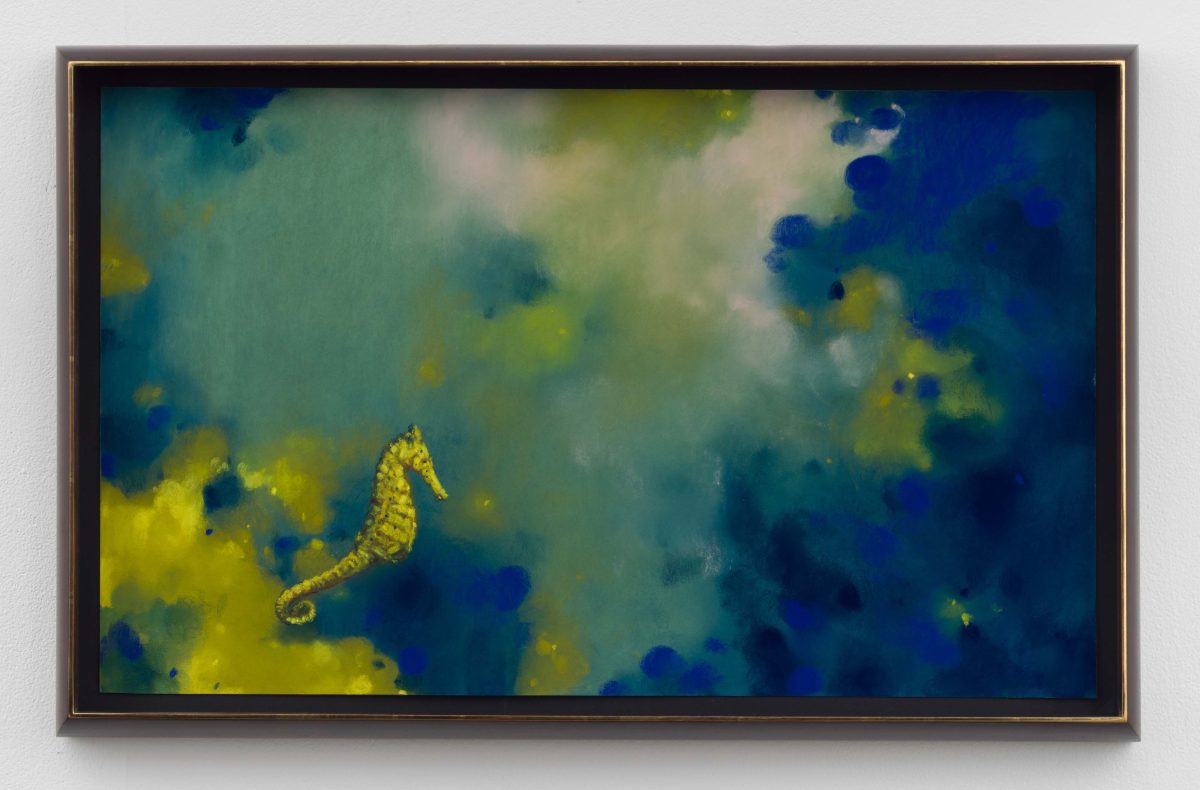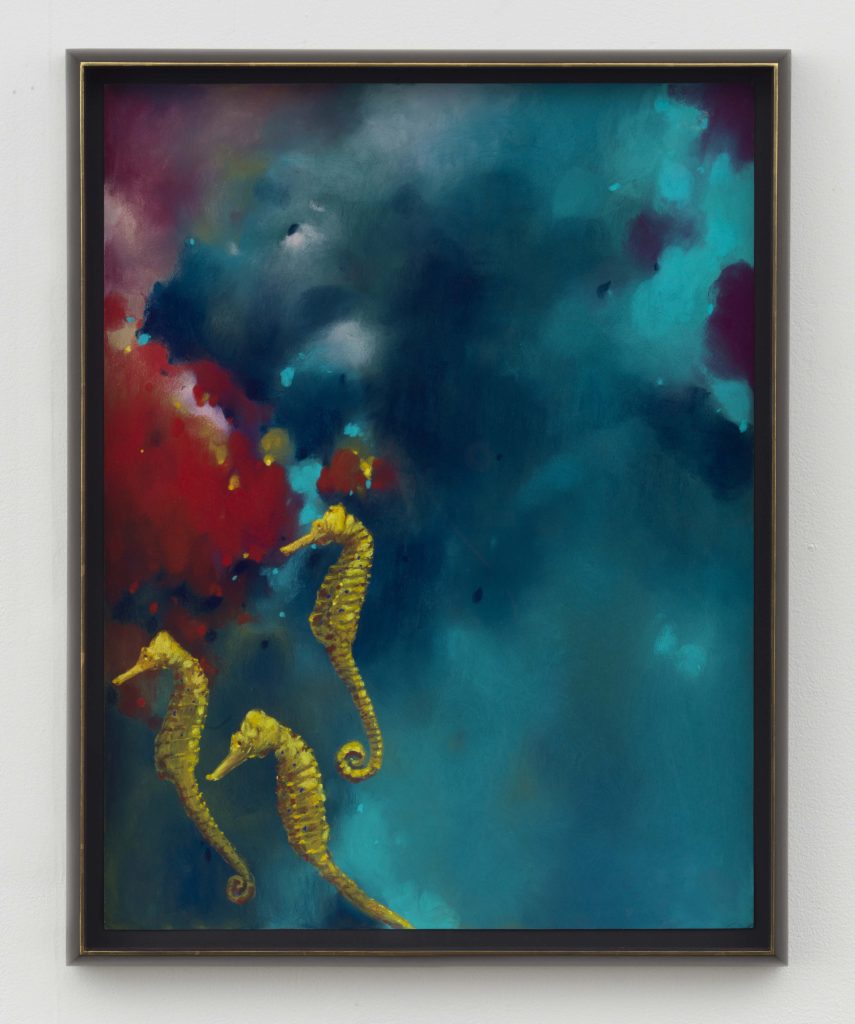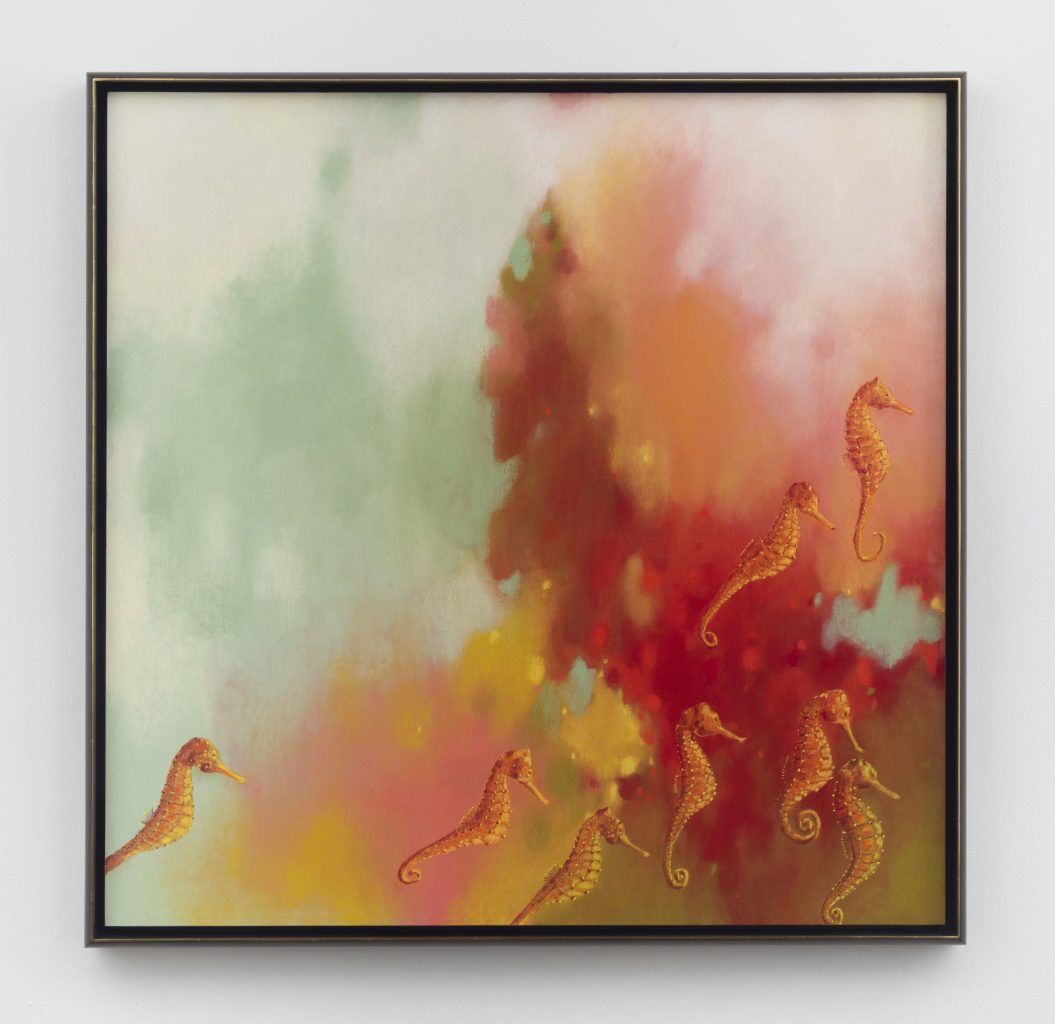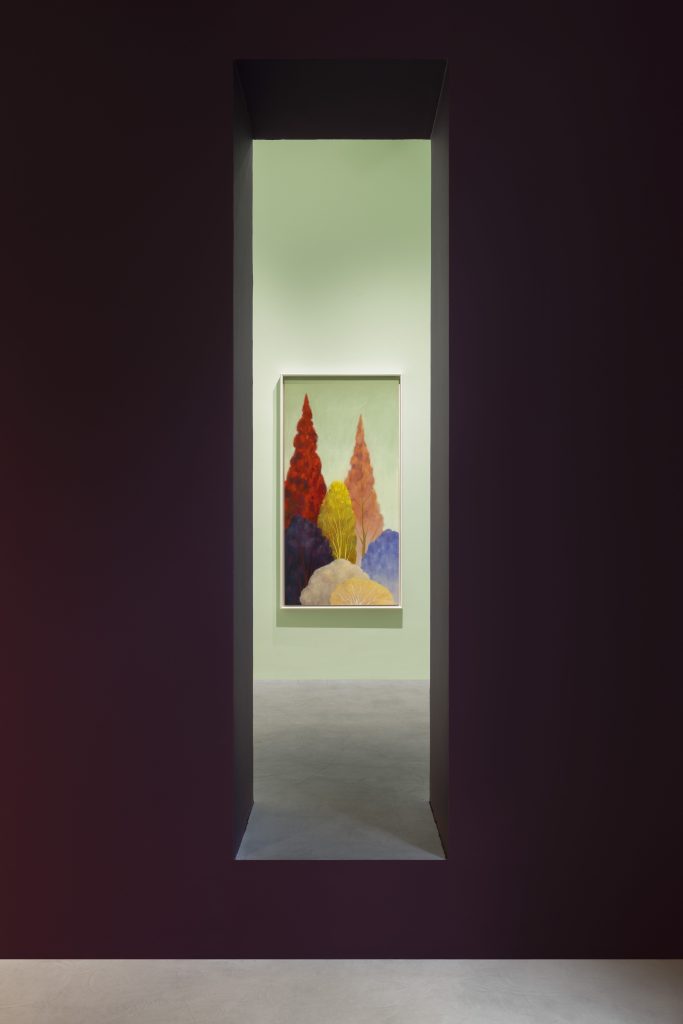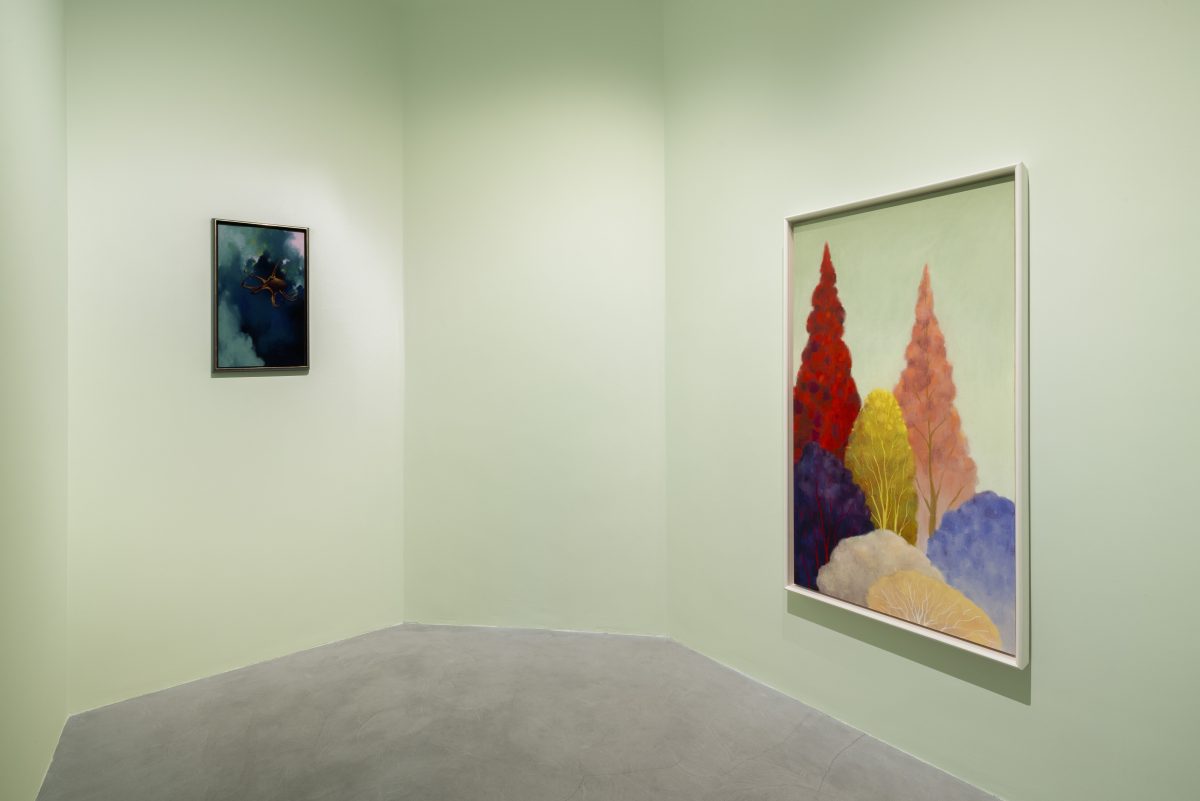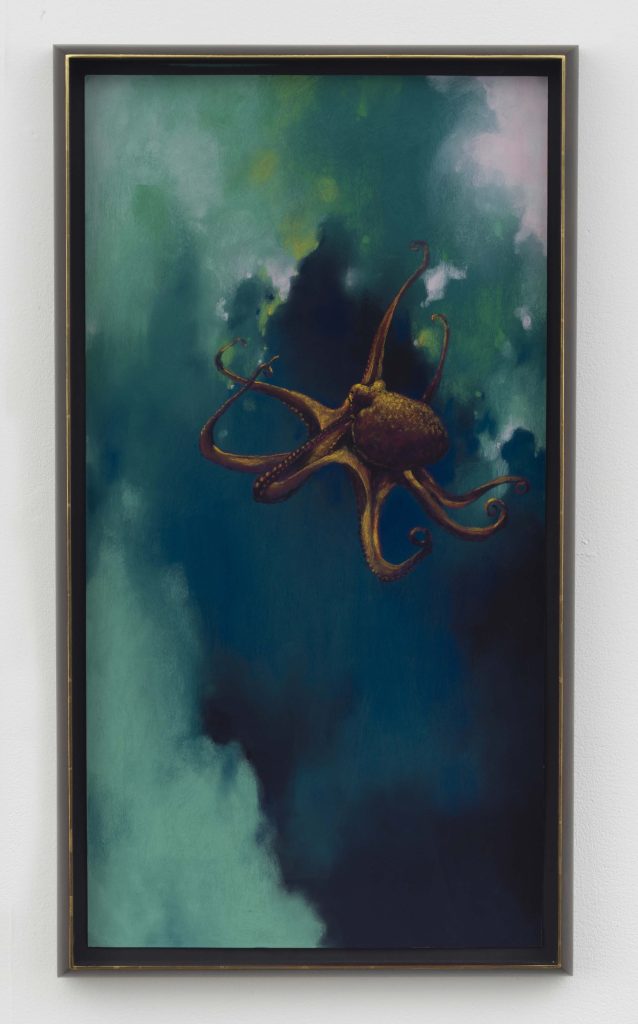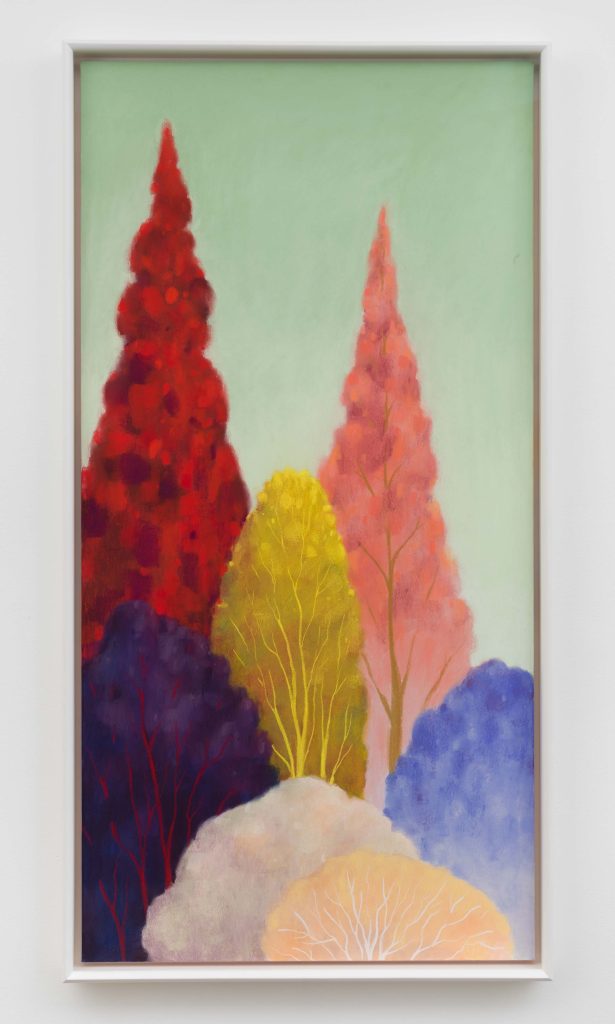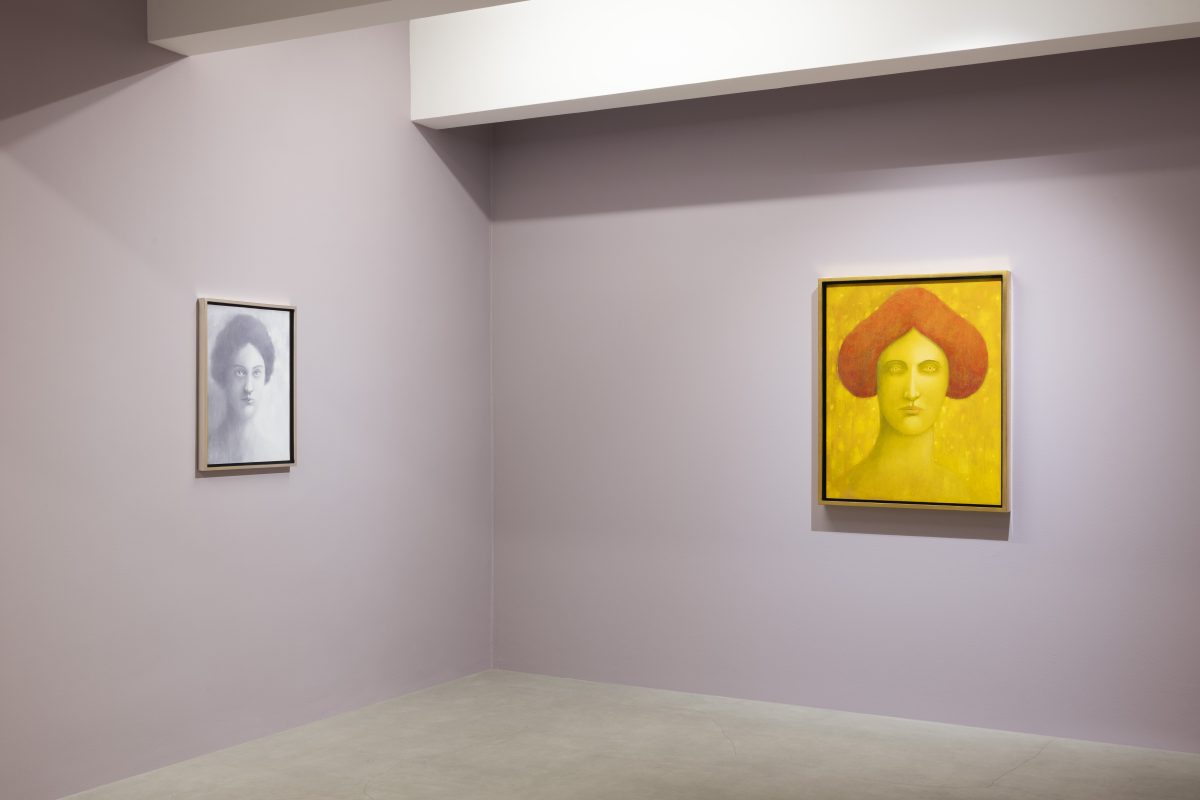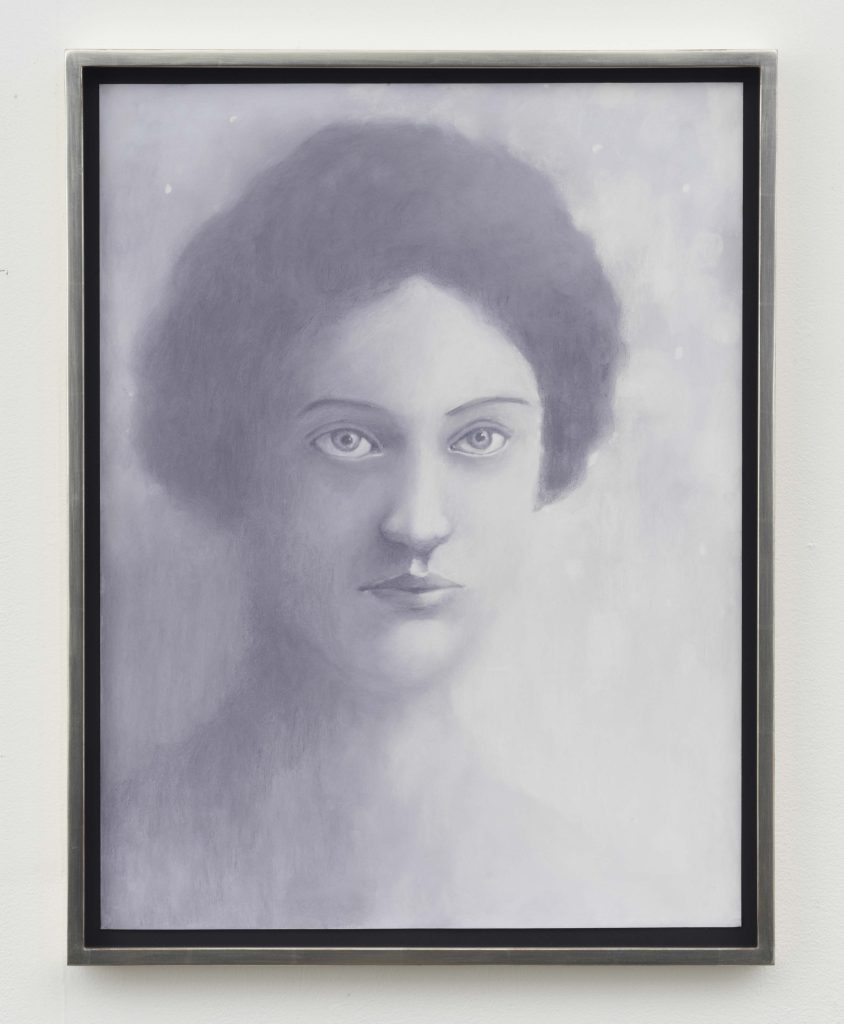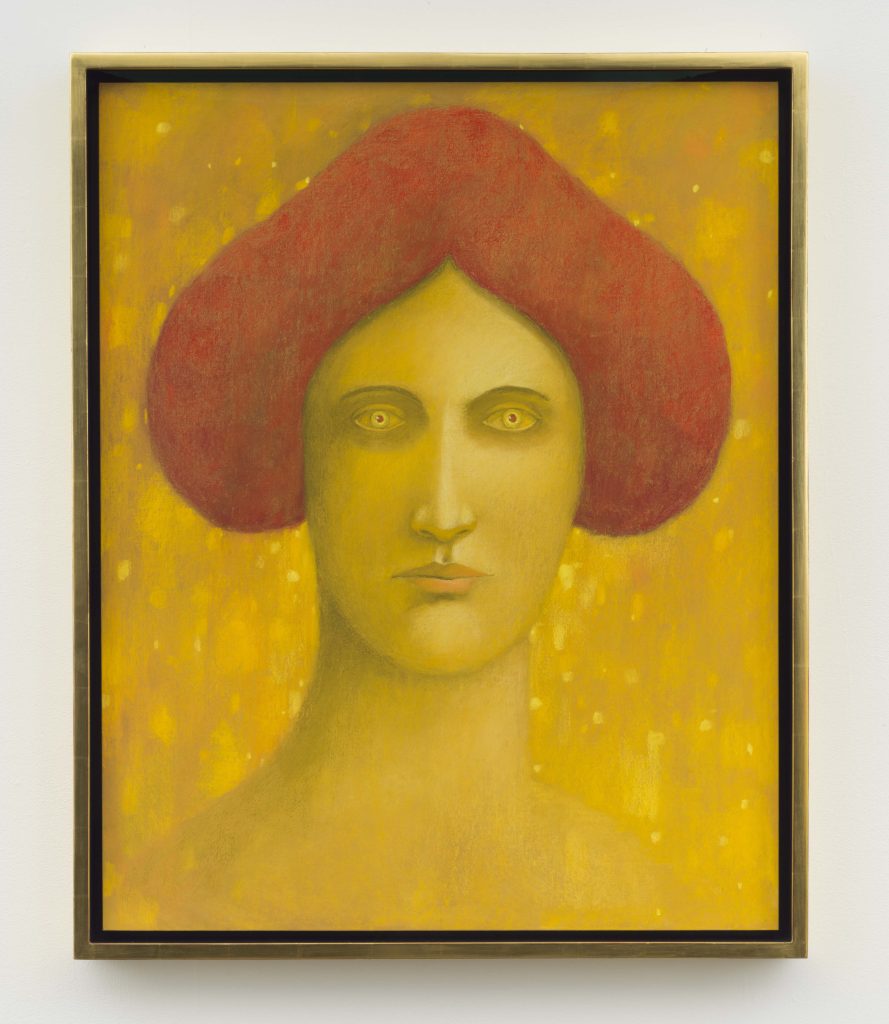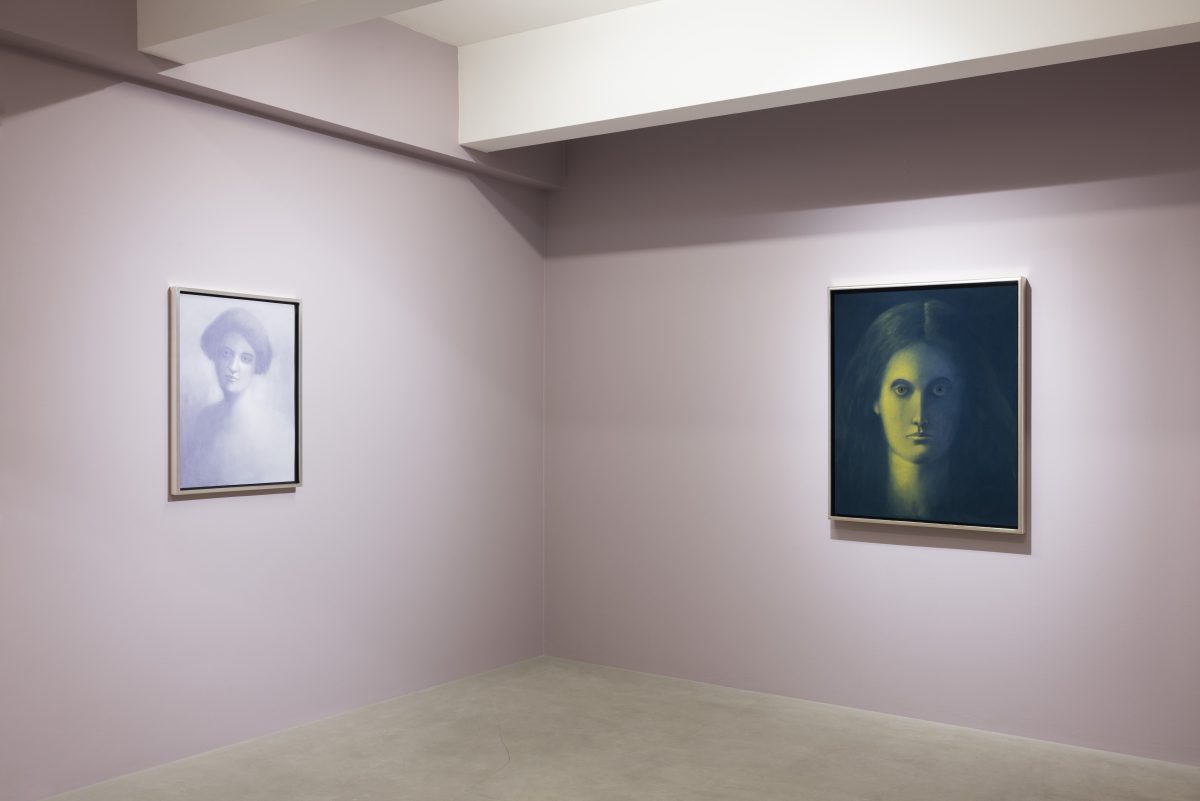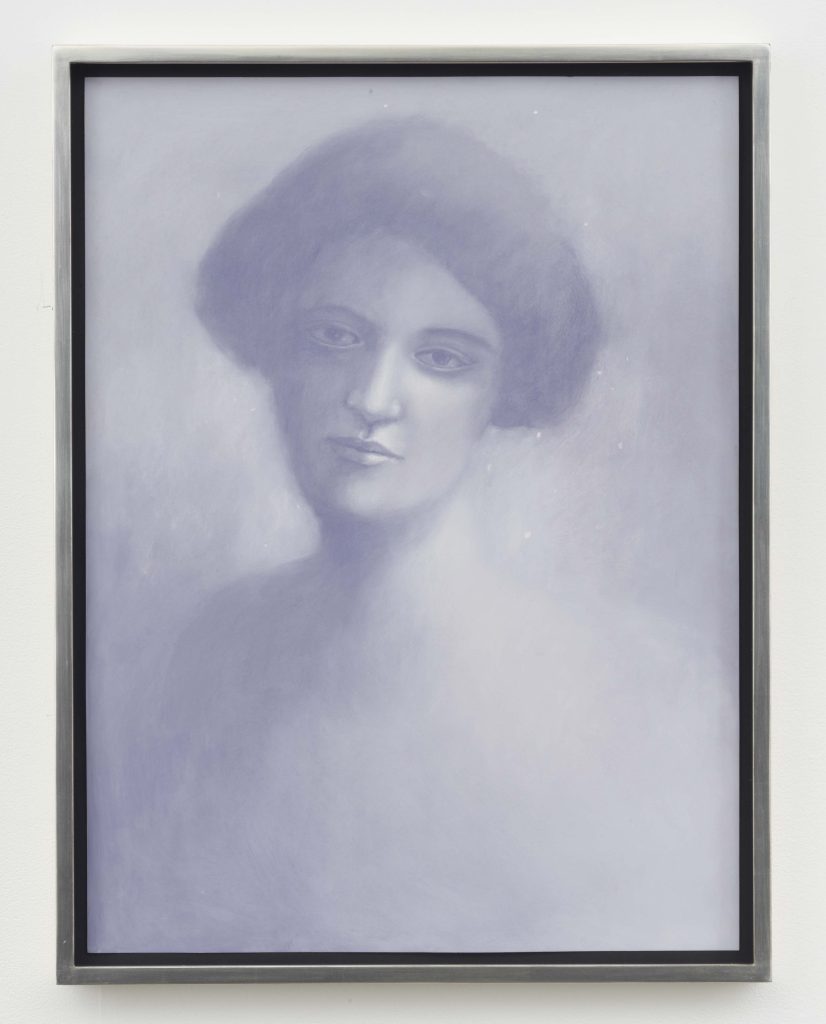
- This event has passed.
kaufmann repetto is pleased to announce Seahorse, Nicolas Party’s third solo exhibition with the gallery, opening in Milan on April 10th. Party’s new pastels present an array of subject matters, ranging from portraits and forests to aquatic fauna, staged in a dreamlike setting suffused with swirling nebulae and atmospheric explosions. The voluptuous gravity of his previous compositions, with concisely defined forms and solid, color-saturated surfaces, gives way to a fantastic vision which conjures a more unstable universe, pervaded by a feeling of evanescence and fragility.
Rich in associations in cultures throughout the world, seahorses and octopuses are floating in colorful aquatic environments while moths are gliding through golden clouds. Captured with illusionistic precision, the animals seem to have paused in the midst of their movements, insinuating a sense of fugacity to the scenes. With their long snouts and armored bodies, seahorses have always been observed with benevolent curiosity and wonder, sparked by their unusual behaviors such as couples holding tails, and males giving birth and nursing the offspring. Octopuses, since antiquity ascribed to the sphere of mythological sea creatures, have appealed to human’s imagination by virtue of their bizarre appearance, their eccentric abilities, and their high intelligence. Both species have in common sophisticated visual tactics: seahorses can camouflage their flexible bodies within their surroundings, mimicking the forms and shades of coral branches and seaweed, while octopuses, the masters of trickery, can entirely change the color of their skins when going into hiding. Metamorphosis is also what characterizes the life cycle of the moth and of its more prominent sibling, the butterfly. Among the most frequently represented animals in art history, these winged insects have been employed as vivid symbols of the fleeting nature of beauty and life’s ephemerality. The moths’ fatal attraction to flames has further contributed to this long-lasting fascination, marking them as the melancholic harbingers of death.
Taking up the symbolic importance of these subjects, the surroundings that provide the fauna’s habitat are transformed by Party into a highly ambiguous environment. Harnessing the luminous intensity of pastel, the powdery pigments are used to evoke the layered effects typically achieved by watercolors, creating swirly vortexes and vaporous expansions. Seahorse, octopus and moth all seem to hover through the same enigmatic nebulous substance, halfway between a liquid and a gas. Its complex polychromies might hint at looming environmental disasters: the vivid hues of yellow and orange could be reflections of devastating fires, while gloomy dark swirls evoke water masses contaminated by dangerous liquids. The animals’ enchanting vitality seems to be threatened by fastly approaching extinction, fueling our widely perceived anxieties for the collapse of the ecosystem. Deliberately oscillating between naturalistic description and dystopian dream, these works are also an homage to Odilon Redon’s Wonders of the Sea, a series of pastel where elements of observed reality amalgamate into bizarre and wondrous underwater visions. Like the French artist, Party affirms painting as an imaginative space, able to reshape our perception of reality into reverie-like disorientation.
Also those works that channel his longstanding interest in specific genres denote a shift in the artist’s approach. In previous landscapes, trees are generally depicted in their entirety, the vertical trunks rooted to the ground and transmitting a sense of firmness. With their slender branches and foamy tufts of multicolored leaves, the forest paintings presented in this show focus instead on the softly waiving canopies, hence on the impermanent part of the tree which transforms during the seasons. Likewise, in a series of new portraits the statuary aplomb of Party’s iconic busts and torsos gives way to soft-focus close ups in mutable flows of steely grey reminiscent of the Pre-Raphaelite–inflected aesthetic of Victorian photographer Julia Margaret Cameron. Allowing some degree of realism in the depiction of these diaphanous physiognomies, the artist seems to leave us space for a more empathic identification with the anonymous sitters. But at the same time, by evoking the hazy blurriness of the early photographic medium, their facial features are already fading away, and the tenuous relationship between the viewer and the viewed dissolves into transcendence. Ultimately, the fleetingness of artistic expression becomes a metaphor for the precarious fragility of life, a theme that underpins the entire exhibition.
kaufmann repetto è lieta di annunciare Seahorse, la terza personale di Nicolas Party con la galleria che inaugura a Milano il 10 aprile.
I nuovi dipinti a pastello di Party propongono tematiche che spaziano dai ritratti e dalle foreste alla fauna acquatica rappresentata in un’ambientazione onirica pervasa di nebulose vorticanti ed esplosioni atmosferiche. La solidità voluttuosa delle sue opere precedenti, con forme delineate in modo conciso e superfici sature di colori, lascia spazio a una visione fantastica che rievoca un universo più instabile, pervaso da una sensazione di evanescenza e fragilità.
Presenti nelle culture di tutto il mondo, cavallucci marini e polpi fluttuano in ambienti acquatici colorati, mentre le falene si librano attraverso nuvole dorate. Ritratti con precisione illusionistica, gli animali sembrano come immobilizzati nel loro movimento, insinuando un senso di fugacità nelle scene. Con i loro musi affusolati e le loro armature, i cavallucci marini sono sempre stati guardati con curiosità e meraviglia benevole grazie ai loro insoliti comportamenti: le coppie che si tengono per le code, i maschi che danno alla luce e curano la prole. I polpi, appartenenti sin dall’antichità alla sfera di creature marine mitologiche, hanno colpito l’immaginazione umana in virtù del loro aspetto bizzarro, delle loro eccentriche abilità e della loro notevole intelligenza. Entrambe le specie condividono sofisticate tattiche visive: i cavallucci marini possono mimetizzare il proprio corpo flessibile nel loro ambiente, imitando le forme e le tonalità dei rami di corallo e delle alghe, mentre i polpi, maestri d’inganno, riescono a cambiare completamente il colore della propria pelle mentre si nascondono. La metamorfosi caratterizza anche il ciclo di vita della falena e della sua più illustre sorella, la farfalla. Tra gli animali più rappresentanti nella storia dell’arte, questi insetti alati sono stati impiegati come simboli della natura effimera della bellezza e della caducità della vita. Contribuisce a questa fascinazione di lunga data la fatale attrazione per le fiamme da parte delle falene, che le rende malinconiche messaggere di morte.
In un richiamo al significato simbolico dei soggetti, lo spazio che fa da habitat alla fauna è trasformato da Party in un’ambientazione estremamente ambigua. Sfruttando i luminosi colori a pastello, i pigmenti sono impiegati per evocare l’effetto di sovrapposizione tipico dell’acquarello, creando vortici turbinosi e vaporose dilatazioni. Cavalluccio marino, polpo e falena, sembrano tutti sospesi nella stessa vaporosa sostanza enigmatica, a metà tra liquido e gas, le cui complesse policromie accennano alla minaccia incombente di disastrosi eventi ambientali: le vivaci tonalità del giallo e dell’arancione potrebbero essere il riflesso di incendi devastanti, mentre la cupa oscurità dei turbinii evoca masse d’acqua contaminate da pericolose sostanze liquide. L’affascinante vitalità degli animali colta nei dipinti sembra essere minacciata da una estinzione imminente, alimentando ansie diffuse per il collasso del nostro ecosistema. Oscillando deliberatamente tra descrizione naturalistica e sogno distopico, le opere sono anche un omaggio a Wonders of the Sea di Odilon Redon, serie di dipinti a pastello dove elementi della realtà osservata si amalgamano in visioni sottomarine bizzarre e meravigliose. Al pari dell’artista francese, Party intende la pittura come uno spazio immaginifico, capace di riplasmare la nostra percezione della realtà in un disorientamento onirico.
Anche le opere in cui torna su tematiche familiari denotano un cambiamento nell’approccio da parte dell’artista. Nei precedenti paesaggi, gli alberi erano di solito ritratti nella loro totalità, con i tronchi verticali ben radicati a terra a trasmettere un senso di solidità. Per contro, con i loro esili rami e i ciuffi ariosi di fogliame multicolore, i dipinti di foreste presenti in questa mostra si focalizzano sulle chiome che ondeggiano dolcemente, e quindi sulla parte transitoria dell’albero che si trasforma nel corso delle stagioni. Analogamente, in una serie di nuovi ritratti, lo statuario aplomb degli iconici busti e torsi di Party lascia spazio a primi piani sfocati in un fluire mutevole di grigi acciaio che rievoca l’estetica preraffaelita della fotografa vittoriana Julia Margaret Cameron. Introducendo un certo grado di naturalismo nella raffigurazione delle loro fisionomie diafane, l’artista sembra concederci spazio per un’identificazione più empatica con gli anonimi soggetti. Ma allo stesso tempo, evocando la confusa sfocatura della fotografia degli esordi, i tratti facciali stanno già scomparendo, e la tenace relazione tra osservatore e osservato si dissolve in trascendenza. In ultima analisi, la fugacità dell’espressione artistica assurge a metafora della fragilità della vita, una tematica che sostiene l’intera mostra.


